ORTOFON - the vinyl playback reinvented
Back in 1958 the Ortofon SPU sounded like no other cartridge because it was way ahead of its competition. Today the SPU still has a sound that is definitely its own, characterized by rich bass and transparent treble range plus those extra qualities which are so hard to define, but so easy to appreciate when they are realized.
In the vinyl world the Ortofon brand is unavoidable. From The Beatles mono mastering to the finest audiophile candies the cartridges and accessories from the Danish manufacturer represent landmarks in the industry. It is my pleasure to share the opinions and thoughts of Ortofon’s experts with our readers. Let them speak.
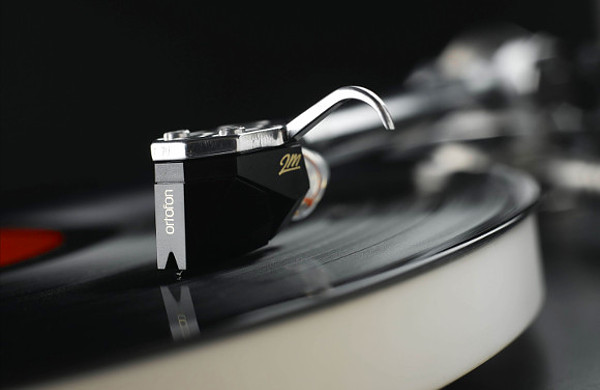
The cartridge principles
Since the turntable business had been conceived the fundamentals of the phono cartridge did not change that much. The two main principles are used:
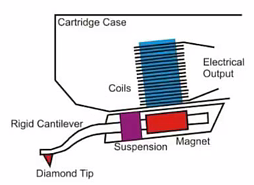
A Moving Magnet (MM) cartridge is generally considered to be easier to produce, yet not as precise as MC due to heavier cantilever. The advantages of such a design are twofold – the stylus of a MM can be replaced and the cartridge does not need a preamplifier.
The reading movement of a diamond tip in a record’s groove is transferred through the rigid cantilever to the magnet that moves in front of coils, thus generating electrical output from the coils (typically the magnet is surrounded by 2 coils). The impedance output is high, 40kohms.
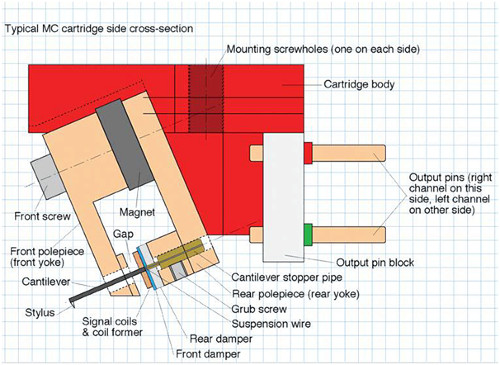
A Moving Coil (MC) requires much more precise manufacturing that very often involves a lot of manual labor. The design is lighter and is considered to deliver more precise sound reproduction. The drawback is the price that comes with costs and the fact that its stylus cannot be replaced at home.
The MC is a system that is functionally inverse to MM - the coil windings are part of the cantilever and move in the fixed magnetic field, thus generating the electrical output. Output voltage is lower than with MM - therefore preamplifier is needed – and the output impedance is also lower, typically 5 ohms.
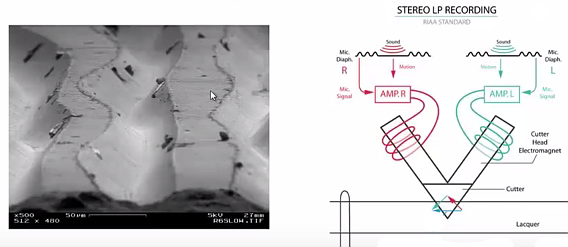
Reading the groove
The groove is what it says: the groove. Take a wooden stick and pull it through soft mud after rain – this is exactly what is duplicated at vinyl records. The cutting lathe directly cuts the signal from analog to the groove which results in up and down and side to side variations in the movement of the writing stylus (or reading during playback). On the picture you can also notice black spots, i.e. material impurities that affect the sound quality.
The stylus is the only thing that is in direct contact with a record - the reading accuracy of the stylus dictates how “the data” are retrieved from the record. Depending on the shape of the stylus (see picture) and how much it is polished the cartridge designers achieve optimized contact between the stylus and the groove.
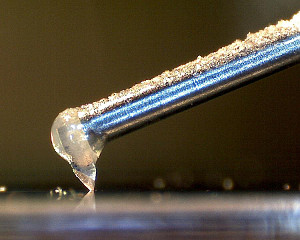
Danish Ortofon further evolves the diamond stylus shapes to track as much of the groove as possible. To achieve this the stylus should maximize its contact surface with the groove – spherical or elliptical tips are no longer sufficient. Thus taller and narrower piece of diamond must be cut and polished with high precision which brings up the costs very fast. Ortofon claims that its Replicant 100 technology styluses readings are almost identical to what the lathe cut into the vinyl.
Some lesser cartridges utilize “tipped” diamond styluses. What does that mean? The stylus is not all-diamond but only uses a diamond tip that is attached to metal body. The problem is that the mass of the whole assembly increases and the stylus is unable to react swiftly to nuances in the groove – it can result in loss of tracking accuracy and impair reading of delicate transient signals. Therefore, for high end applications, the full diamond assemblies are recommended.
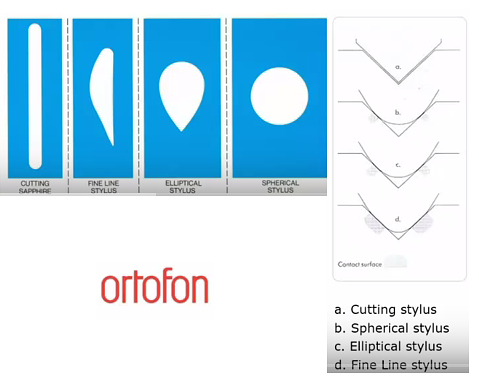
The cantilever is the mediator between the reading stylus and the electromagnetic assembly of the cartridge. As such must be as light as possible and as stiff as possible. Aluminum cantilevers are the industry standard yet the accuracy is improved by using ruby or boron cantilevers. The more expensive does not automatically mean “better” – the cantilever material can affect the sound so it may be that you end up preferring ruby over boron or vice versa.
The resonating cantilever has to be damped as quickly as possible – a new signal is waiting and it does not want to be masked by delayed resonances of the previous signal (we are talking in milliseconds here). Again, the damping material prints its own character onto the sound. In Ortofon they use Lexan DMX in piano lacquer - which is polycarbonate resin compound - or WRD damping system (Wide Range Damping) that utilizes a sandwich of special material disc closed between two rubber absorbers to optimize the damping. By different absorbing properties of the disc and the rubbers the damping is more even across the audible audio range. Ortofon claims that the cartridge performance can be further elevated by application of titanium/elastomer damping system for ultimate performance, like in their TPE assemblies.
How to read technical specifications of cartridges
Serious manufacturers should provide a buyer with a full specification sheet. Quite often, especially with exotic and expensive products, the technical data are missing. It does not mean that the product is always bad but it should trigger an alarm in your head and certain cautiousness should be in place. Here is what Danish Ortofon recommends to look for in phono cartridges data sheets:
Output voltage at 1kHz [micro-Volts or mili-Volts]: If it is too low the system would require a dedicated phono preamplifier or a step up transformer that would add necessary dB gain.
Channel balance at 1kHz [dB]: indicates an overlap between the channels, i.e. the lower, the better.
Channel separation at 1kHz/10kHz/15kHz[dB]: indicates the separation of L/R channels, the the higher the better. Also check the performance at different frequencies (if the supplier provides this type of information) as an excellent performance at 1kHz may become a mess at 15kHz, for example.
Frequency range [Hz]: typically between 20Hz and 20kHz.
Tracking ability at 315Hz [micro-meters]: ability to track the groove, the higher the better.
Stylus tip and stylus radius [micro-meters]: says how much the stylus is able to track the footprint of the groove. Usually comprises of two radius numbers – the first defines the radius of the stylus itself, the second defines the footprint radius. Values like 5/70 micro-meters are great. The higher the latter is, the better.
Tracking force [mN]: recommendation for setting the force of the cartridge.
Recommended load impedance [ohms]: important for setting your preamplification or step up transformer correctly.
Cartridge weight [g]: summing up the weight of the cartridge, headshell and the tonearm is essential for balancing the weight of the whole system right.
For MM only you need to know other recommendations too: internal inductance [mH, load resistance [kilo-ohm], recommended load capacitance [pF, including the cable].
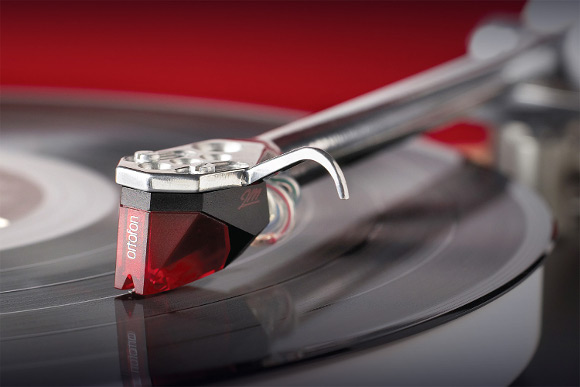
Ortofon comes with color codes that roughly say to which level of performance the cartridge is targeted.
Red – this is the entry level with good value for money.
Blue – brings more upfront sound with more HF precision.
Bronze – true analog with warm and detailed sound.
Black – the reference point of the company.
In MM (Moving Magnet) cartridges the OM series represent the standard for anyone who is “new” to the vinyl world. Slightly less advanced may reach for 2M series that is compatible with majority of turntables (the 2M name means two M’s in Moving Magnet). Ortofon provides two versions of the 2M cartridges – for bottom and top mount – as well as a complete “Plug Play” set of the cartridge and the headshell that looks cool on any turntable. The already famous 2M Red features a tipped Elliptical diamond and split pole pins with a copper wire, the top-of-the-MM-range 2M Black is modestly nicknamed “the best MM cartridge in the world”.
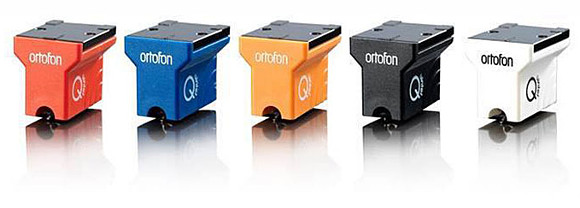
The MC (Moving Coil) cartridges has been produced in Ortofon since 1948. The accumulation of the know-how resulted into MC Quintet series that was launched in 2014. Quintets have tuned thermoplastic bodies with neodymium magnets and they are less sensitive to load due to low internal impedance which makes them compatible with the widest range of preamplifiers and step up transformers. Moving up through the Cadenza series one gets to more exclusive cartridges:
MC Windfeld pays tribute to a former Ortofon’s designer Per Windfeld. It features extremely low mass stylus of Replicant 100 type with wide range damping system, magnetic field stabilizing system and boron cantilever. A listener can expect tonal neutrality, rich textures and extended top end.
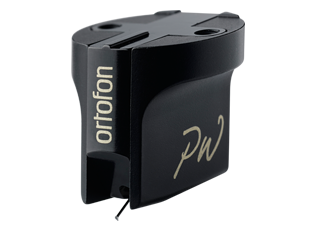
Xpression also uses Replicant 100 diamond stylus, housed in stainless steel and TPE compound shell that represent universal mount. The cartridge utilizes Ortofon’s Wide Range Damping system and gold plated copper wiring. Listeners highlight detailed presentation, openness and palpability of the sound from the Xpression.
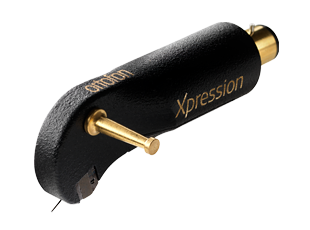
The beautiful diva Anna Netrebko has inspired the MC Anna cartridge. It features new high efficient magnet system, titanium body and improves upon Xpression in many small advancements. What to expect? Natural sound that is silky smooth, refined and dynamic.
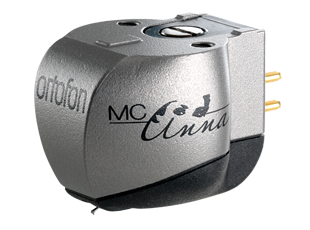
MC A95 has been launched recently to commemorate the 95th anniversary of Ortofon. The MC A95 has gone to the next level by reducing unwanted vibrations and increasing the dynamic capability of the cartridge. Those who choose to adopt the MC A95 will experience the lifelike, open sound, with exceedingly clear midrange for a presentation that is unparalleled. The MC A95 remains extremely musical while paying close attention to micro dynamic details, with its delicate, but also analytical nature.
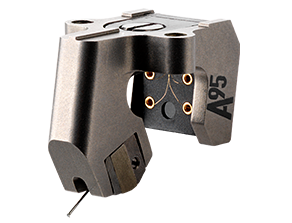
The wonderful mono world
The modern vinyl took over from phonograph records in the late 40’s when recording and cutting equipment allowed to increase the frequency range – it rose from 8kHz to 14kHz thus ushering the “high fidelity” era. It was in 1948 that the microgroove vinyl record was introduced. It required a new and better material (which became known as what we now call vinyl), new cutterheads, new recordings that lasted an entire record side, and new turntables that could spin at 33rpm. Even more notably, new lightweight tonearms and cartridges were required to significantly lower the 100+ grams tracking forces that were common for use with 78rpm shellacs.
In the mono microgroove geometry the signal is cut in the lateral dimension only - meaning that the V-shaped groove will have constant width and depth and that there is no vertical information (unlike stereo). The groove angle of the V-shape will vary a bit from record to record but will always be close to 90 degrees, minimum width has varied due to changing standards but has always been close to 50µm until the mid 1960s. The latest standards from the 1980s were revised for a minimum width down to around 30µm. This offered a unified standard, congruent to the minimum width of stereo records.
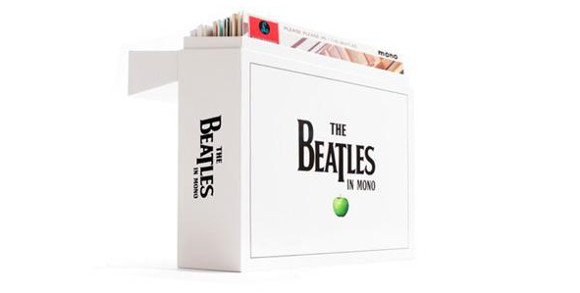
If you play a mono record with a stereo cartridge you will not achieve the same signal in the two channels due to imperfections such as crosstalk, noise, phase errors, tracking error, antiskating and distortion. This difference between the channels will result in an unstable and partially fuzzy image. A mono switch, to some extent, can improve this.
Playing the same record with a mono cartridge will have none of the aforementioned problems, as this cartridge only produces one signal, which afterwards is directed to both channels in the system. This will provide a much more forceful and stable image with a fuller sound.
Another significant advantage of using a mono cartridge to play mono records is the absence of response to vertical movement. This means that a mono cartridge is essentially impervious to the pinching effect which comes into action when the stylus is pushed vertically upward in very narrow grooves. In addition, the response to dust, dirt and wear will be reduced substantially as the vertical component will not be heard. The final result will be a much more clean and noiseless reproduction of the mono record. These effects simply cannot be achieved merely by the use of a mono switch.
Most records from early microgroove era were played with a spherical stylus. This will not, however, mean that mono has to be played with a spherical stylus. In fact, elliptical types as well as line contact types can be highly beneficial for mono records from the mid 1950s and upwards, according to Ortofon. The line contact types, specifically, will ensure an improved high frequency response due to the slim shape. Also the distortion from the pinching effect, which occurs when the stylus is pushed upwards due narrow high frequency grooves, will be reduced substantially.
The Beatles
This kind of groove will make it possible to use most modern mono cartridges without any problems. However, to get the most out of the grooves, a line contact type like the Fine Line on the MC Cadenza Mono or the Shibata on the specially developed 2M Mono SE will be perfect.
2M Mono SE is effectively the cartridge from Ortofon used by GRAMMY®-winning engineer Sean Magee and GRAMMY®-winning mastering supervisor Steve Berkowitz for replay when mastering the new mono albums for vinyl from quarter-inch master tapes.
To become a real vinyl expert I encourage you to go through the very informative Ortofon’s website or check their online training academy for further tips and tricks.
In 1948 Ortofon developed its first moving coil cartridge, since then more than 300 different cartridges have been developed and manufactured. The Ortofon manufacturing unit in Nakskov in the south of Denmark has modern machinery combined with experienced operators, so human craftsmanship is delivered with uniform industrial quality. Today Ortofon is a fine mechanical powerhouse, which develops, manufactures and markets the world acclaimed Ortofon cartridges and components for the hearing aids industry. www.ortofon.com
Kontakt: Horizon Trading Prague s.r.o., tel: +420 731488630 / +420 606346822, www.ortofonaudio.cz




